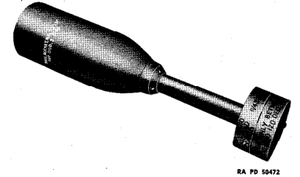7.2-Inch Demolition Rocket
| T37 | |
|---|---|
 | |
| Type | Surface-to-surface rocket |
| Place of origin | United States |
| Service history | |
| Used by | United States Army, United States Navy |
| Production history | |
| Designer | Caltech |
| Designed | 1943 |
| Produced | 1944–1945 |
| Specifications | |
| Mass | 61 lb (28 kg) |
| Length | 35 in (890 mm) |
| Diameter | 7.2 in (180 mm) |
| Warhead | C2 explosive[1] |
| Warhead weight | 32 lb (15 kg) |
| Engine | Solid-fuel rocket |
Operational range | Minimum: 300 yd (270 m) Maximum: 3,400 yd (3,100 m) |
| Maximum speed | 110 mph (49 m/s) |
Guidance system | None |
The 7.2-Inch Demolition Rocket, also known as the T37, was a 7.2-inch (180 mm) rocket developed and used by the United States military during World War II. Derived from the "Mousetrap" anti-submarine rocket, it was intended for use in demolishing concrete bunkers and fortifications, and saw use from August 1944.[2]
Development[edit]
The 7.2-Inch Demolition Rocket was developed by Section L of the National Defense Research Committee, located at Caltech,[3] in late 1943 as a modification of the existing 7.2 in (180 mm) ASW rocket (Mousetrap) for use against heavily fortified ground targets. Assigned to the United States Navy for development and production in July 1944,[4] An additional high-explosive rocket, the T24, was planned, but was dropped in favor of the T37.[5] The rockets utilized a standard 2.25-inch (57 mm) rocket motor, fitted with a larger-diameter warhead; a longer-ranged version utilizing a 3.5-inch (89 mm) motor was also produced.[6]
Operational history[edit]
The T37 saw its first operational use during Operation Dragoon, the invasion of southern France, in August 1944,[7] fired from 120-round "Woofus" launchers mounted aboard Landing Craft Rocket vessels offshore.[8]
The rocket was also intended to be fired from tanks for the clearing of bunkers and anti-tank obstacles. The initial launcher, dubbed "Cowcatcher", was mounted on the front of M4 Sherman tanks;[9] it was quickly found unsatisfactory, and was replaced by 20-round (T40 "Whiz Bang")[10] and 24-round ("Grand Slam") launchers mounted atop the tank's turret.[7][9] The 20-round launcher could fire its entire loadout of rockets in approximately 10 seconds;[11] however the tank installation was unpopular with crews, as the launcher prevented the tank's turret hatches from being opened.[9]
References[edit]
Citations[edit]
- ^ "U.S. ROCKET, 7.2-IN, DEMOLITION, T37". ORDATA Online. Mine Action Information Center. Archived from the original on 15 July 2012. Retrieved 24 May 2012.
- ^ https://www.designation-systems.net/dusrm/app4/7inch.html
- ^ von Braun, Ordway III and Dooling 1985, p.97.
- ^ Hearings of the Committee on Expenditures in the Executive Departments. United States House of Representatives. 1947. p. 117.
- ^ Ordnance School Text: Rockets and Launchers, All Types (PDF). Aberdeen, Maryland: Ordnance School, Aberdeen Proving Grounds. February 1944. p. 93.
- ^ "Rocket, Solid Fuel, H.E. (High Explosive), 7.2in". National Air and Space Museum. Smithsonian Institution. Retrieved 29 February 2012.
- ^ a b Parsch 2006
- ^ Baxter 1968, p.114.
- ^ a b c Zaloga 2011, pp.35-36
- ^ Zaloga 2012, p.16.
- ^ TM 5–220: Passage Of Obstacles Other Than Mine Fields. War Department Technical Manual. United States War Department. July 1945. p. 50.
T37 demolition rocket.
Bibliography[edit]
- Baxter, James Phinney (1968). Scientists Against Time. Cambridge, Massachusetts: The MIT Press. p. 114. ISBN 978-0-262-52012-6.
- Parsch, Andreas (2006). "Surface-Launched 7.2-Inch Rockets". Directory of U.S. Military Rockets and Missiles Appendix 4: Undesignated Vehicles. Designation-Systems.net. Retrieved 29 February 2012.
- von Braun, Wernher; Frederick I. Ordway III; Dave Dooling (1985). Space Travel: A History : An Update of History of Rocketry & Space Travel. New York: Harper & Row. ISBN 978-0-06-181898-1.
- Zaloga, Stephen (2011). Armored Attack 1944: U.S. Army Tank Combat in the European Theater from D-Day to the Battle of the Bulge. Mechanicsburg, Pennsylvania: Stackpole Books. pp. 35–36. ISBN 978-0-8117-0769-5.
- Zaloga, Stephen (2012). US Marine Corps Tanks of World War II. New Vanguard. Vol. 186. New York: Osprey Publishing. p. 16. ISBN 978-1-84908-560-1.
